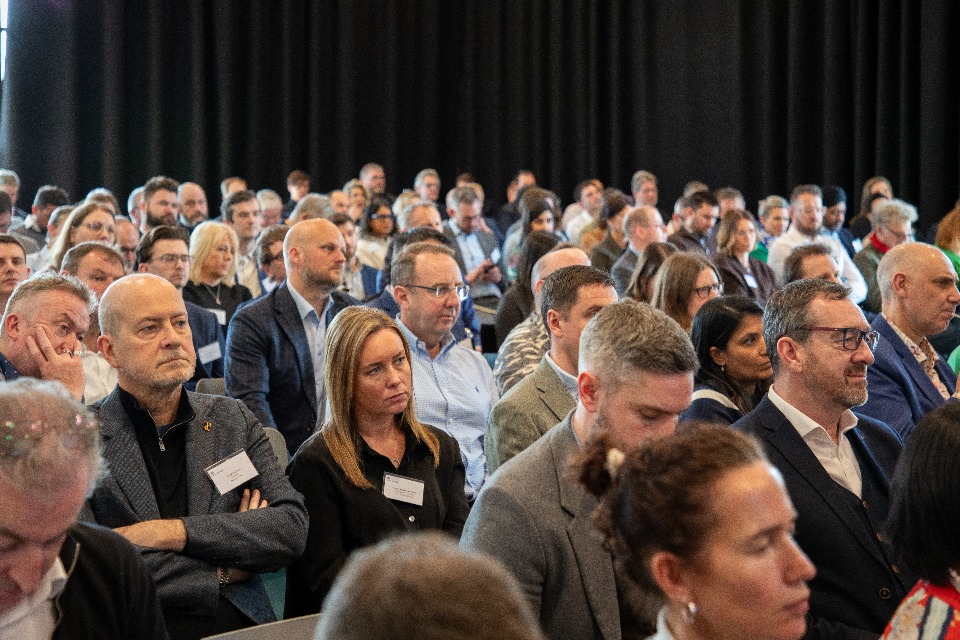A week on from the Places at Pace conference
On 19 March 2024 the Office for Place held its first conference, in our new home of Stoke-on-Trent. A week on from the day, we wanted to share some details on the event, alongside some reflections from our chair, Nicholas Boys Smith.
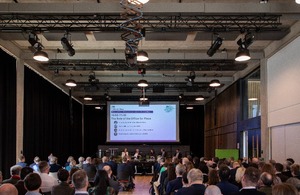
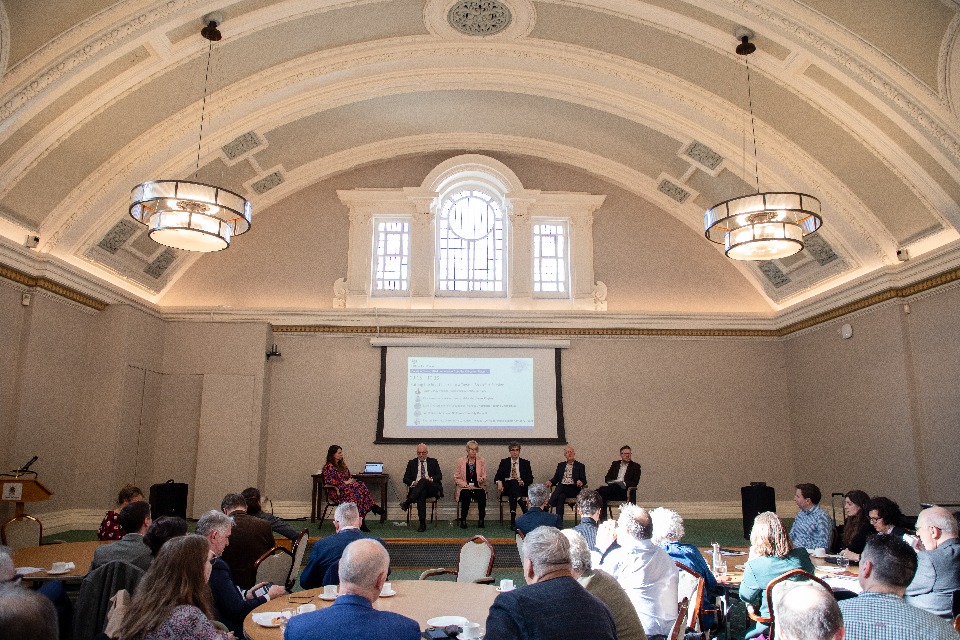
The event took place across two venues, with a breakfast session at Stoke Town Hall opening the day, and the main event happening at Staffordshire University’s Catalyst conference centre. With attendees from the public, private, and third sectors, we were delighted to see both events at capacity, with over 50 delegates at the Town Hall and over 180 at the Catalyst.
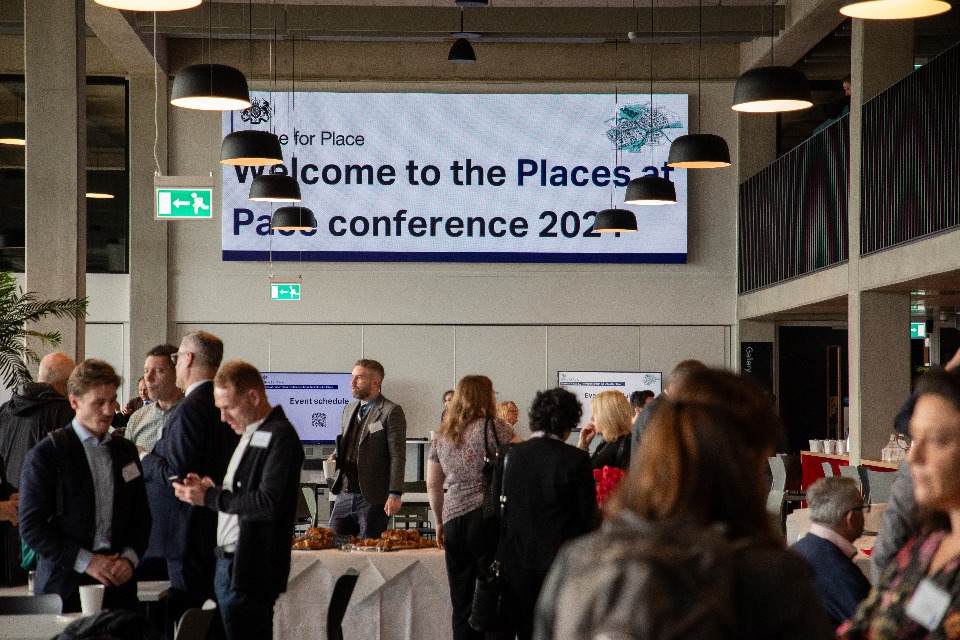
The day opened with a chance for the sector to quiz the us – the Office for Place – on how exactly we can support them. Following this, we were delighted to have both Chris Boardman MBE (National Active Travel Commissioner - Active Travel England) and Mary Parsons (Director of Regeneration & Partnerships at Lovell Partnerships Ltd, and former Building Better, Building Beautiful commissioner) discuss their breadth of knowledge on how we can deliver better places.
Across the remainder of the day, and through both plenary and breakout sessions, our speakers addressed important topics – how design codes can work at different spatial scales, how setting clear asks on quality can de-risk the development process, how placemakers can better understand what people like and value, and how digital can transform the planning and development sector – amongst many others. The day closed out with Lee Rowley MP, Minister for Housing, Planning and Building Safety, addressing delegates and reinforcing the core message of the conference – that we can deliver better places when government and industry work together.
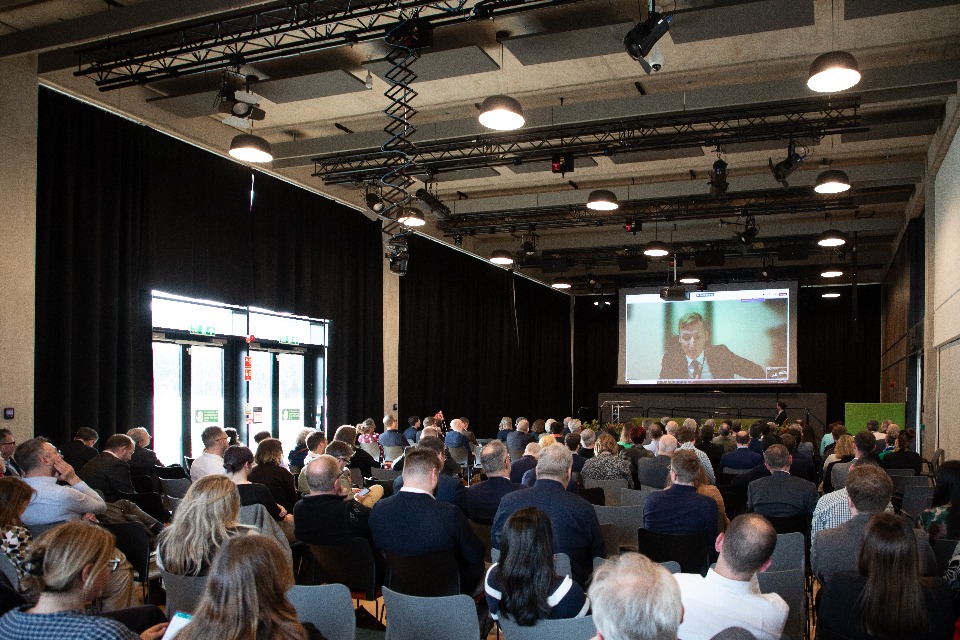
The Office for Place would like to offer our thanks to both speakers and delegates who attended. We hope you found the day to be useful and interesting, and that you’ll join us again next year.
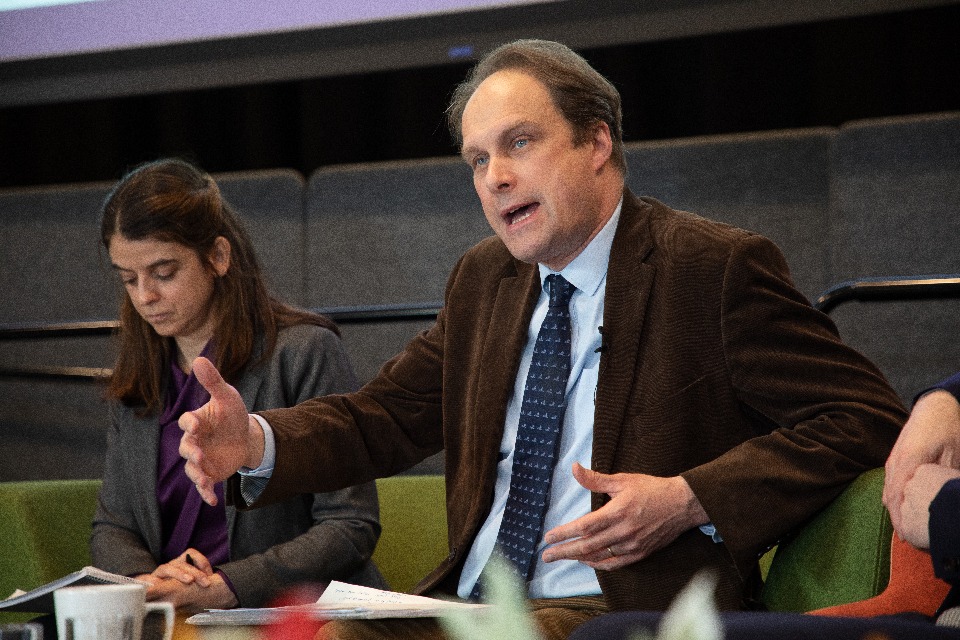
Places at pace: how to fall back in love with the future¬Ý¬Ý
Some reflections from Nicholas Boys Smith, the chair of the Office for Place, on our inaugural conference in our home of Stoke-on-Trent¬Ý
On 18 and 19 March 2024 the Office for Place hosted our inaugural conference in our home in Stoke-on-Trent. Hundreds of leaders and practitioners from the planning, surveying, development, architectural and landscape architect sectors joined my board, officials, and expert advisors for a day of discussions, walking tours, talks and panels. And what a day it was. Four layers of government: Ministers, Whitehall officials, arms‚Äô length bodies and local government. And four agencies leading or participating in conversations: The Office for Place, Active Travel England, Homes England, and Historic England.¬Ý
The feedback (so far) has been fantastic: ‘inspiring,’ ‘impactful,’ ‘a masterclass,’ ‘great,’ ‘insightful’ and ‘a resounding success.’
Our questions included:¬Ý
- What will the evolving planning system mean for developers, councils, and their advisors?¬Ý¬Ý
- How do we de-risk all types of development whilst also raising standards?¬Ý¬Ý
- What does it mean for greenfield and regenerative development in our towns and neighbourhoods?¬Ý¬Ý
- How do we create new places with sufficient urgency and pace?¬Ý
Here are my top take-aways. All normal caveats apply of course: unavoidably subjective and necessarily reflects the conversations I was in not those I wasn’t. For those I have not cited: forgive me please, I could not be everywhere! Doubtless, not everyone present would agree with all of these points. Nor should they. But if there was no monotonal uniformity (thank heavens), there was a choir of pleasingly polyphonic variations upon the same symphony.
1. It’s harder to fix errors than to make them in the first place
Pretty much everyone now agrees that post-war planning did enormous harm to towns and cities, ripping them apart with dual carriageways, retail parks right besides town centres and the general loss of ‘Lego urbanism’ (finely hewn local streets and squares) for ‘Duplo urbanism’ (faceless lumpen blocks in ill-defined spaces). Sadly, in some places it still feels like we are living in the post-war era. As Jon Rouse, City Director of Stoke-on-Trent, reminded us in a superb opening presentation in the city’s glorious Edwardian town hall, ‘repairing the tears in the urban fabric is much harder than making the tears in the first place.’
2. The road to meeting our housing need runs through Stoke-on-Trent and Grimsby not just Sussex and Greater London
Though the path is a different and is (initially) more about increasing demand through regenerative place-improvement and jobs. New development in ‘left-behind’ places need to be centripetal not centrifugal, regenerative not parasitic, energising not dissipating.
3. The need to rebuilt trust in regenerative development not parasitic development is paramount
Mary Parsons of Lovell Partnerships cited an articulate youngster on regeneration: ‘at best it’s a necessary evil.’ Are we creating for the delight of the public or the plaudits of peers? She continued, ‘I’ve never met anyone who wanted to live in an icon. They want to live in a home.’ Christopher Wren (who was not at the conference) wrote that ‘architecture aims at eternity and is therefore the only thing uncapable of modes and fashions in its labels.’ Let’s create places for the plaudit of the people not fellow professionals. Place matters more than decade.
4. Planning is categorically not the proverbial ‘bad guy’ … but we do need to de-risk planning
As one delegate asked, ‘how easy is it to know what you can build where? The reality is that it’s not that easy.’ Amandeep Singh Kalra of Be First agreed; ‘our system’s greatest challenge is its discretionary nature… let’s remove subjectivity to set land values.’ A modular house builder added from the floor; ‘I cannot stress enough the importance of predictability.’ When asked by Andrew Taylor from Vistry, ‘can we ensure that design codes speed things up and don’t slow them down.’ It’s a fair challenge.
5. We do know what makes a good place
Don’t fall for the old canard that ‘design is subjective.’ It isn’t. Where we live, where we walk has very measurable and in large part predictable consequence for our personal health and happiness. We are not automatons controlled by our environment, but we are humans influenced by them as many studies have shown and as Matthew Carmona outlined. Data scientist Chanuki Illushka Seresinhe continued that ‘people are happier in more beautiful places.’ Creating better places is therefore very much about improving health and happiness. ‘We are giving freedom to children,’ as Chris Boardman put it. The interaction between place and movement ran through many of our conversations.
6. Design for children and the elderly and you’ll probably create good places for everyone
Across the world, humans’ needs from their neighbourhoods are remarkably consistent across class and culture though with important ‘slopes’ in the data due to climate and latitude. But it can be harder for the very young and the old to get about: it’s not that, for example, children are different species with completely different needs but, as Toby Lloyd put it, ‘I don’t know many children who drive.’ The same point about the old came up powerfully in one of my conversations. Places carefully considered with children and the elderly’s liberty to move about will probably work better for everyone.
7. Good places are green places
There is a virtuous circle between where we live and the weight with which we tread upon the planet. This is true from street trees’ effect on microclimates to how we move about to the longevity and resilience of beautiful buildings and places whose embodied carbons over time tumbles as they find new uses down the decades. Creating and stewarding good places is ultimately to build not just for our generation but for the future, in communion with the future as well as the present and becoming ‘good ancestors’ as Mary Parsons put it, citing (ultimately) Roman Krznaric.
8. Aiming high helps
The changes in the ‘bar’ within the NPPF with the expanded aims of creating beautiful as well as sustainable places and the shift in the ‘bar’ from schemes needing to be ‘not bad’ to needing to be ‘good’ has provably made it easier for councils to turn down bad design, as Matthew Carmona reminded us. It is an important statement of raised expectations for how we can live as neighbours.
9. You can and should trust the people
And you need to respect what people tell you, not manipulate it. ‚ÄòYou have to give power away,‚Äô as Stoke-on-Trent chief executive Jon Rouse put it. This includes respecting the important role that local councillors play. Technology is already changing the game here. Victoria Hills, chief executive of the RTPI, made the observation that soon, ‚Äòthe public will be able to design their own places with AI.‚Äù Robert Kwolek of Create Streets was unfazed; ‚Äòit‚Äôs an opportunity to be welcomed,‚Äô he judged whilst outlining how working with neighbourhood preferences can boost support; ‚Äòpeople can see in the design code what they said to us.‚Äô¬Ý‚ÄòYou have to give power away,‚Äô agreed Jon Rouse.
10. Beware of fake consultation
‘I’ve seen plenty of codes that just code on what people were going to do anyway. What’s the point of it?’ said Amy Burbridge of Homes England. Asking simple and visual questions is important. Cathy Francis of DLUHC suggested, ‘Let’s start with the question: would I live here. I think that’s a very powerful question.’ So do I.
11. Pride and heritage matter
People care about home. Let’s work with that not against it. As Liam Gregson of the Northern Housing Consortium put it, ‘make the most of historic buildings … as emblems for people to gather around.’ Paul Williams, a Stoke-on-Trent-based member of our expert advisory panel was very powerful on this: ‘don’t underestimate the concept of pride,’ he said, ‘help people realise that they can still love the places they call home.’
12. This is something we can agree on
There are difficult challenges facing modern Britain where there are fissures in public opinion. This isn’t one of them. Anthony Downs, of the Gascoyne Cecil Estate summarised his experience, ‘people are often very clear about what they don’t like.’ I would agree with this based on all my experience the length and breadth of the country and abroad. It can be surprisingly easy to build consensus about what new places should be like if you ask simple and meaningful questions about character and place and actually respond to the answer.
13. Digital planning hasn’t really happened yet
As always, Euan Mills was very compelling on this, ‘PDFs are the very worst model for the web. The web is 30 years old now. But if you ask Chat GPT about planning, it won’t tell you anything because it doesn’t know anything because it is all lost in PDFs.’ Design codes done well will be clear online process of what can, and cannot, be built easily in certain places. They should de-risk development with a clear quality ask. As Amandeep Singh Kalra put it, ‘some local councils are scared of design codes. I would say the opposite is true. They empower councils.’
14. Design codes need to clarify not complicate
A very good question from Andrew Taylor absolutely hit the nail on the head: how do we ensure that design codes clarity what can be built and don’t complicate the process? (I didn’t write the down the precise quote because I was on stage at the time.) This is our collective challenge and opportunity. Here, for now, is our answer by the way: 10 criteria for effective design coding
15. There is a new focus on place and a lot to be hopeful about
There was even a lot of hope about. Our conference chair, Toby Lloyd, judged that ‘it really does feel as if things are moving in the right direction’ and Mary Parsons agreed that ‘we can keep the faith.’ Paul Williams from the Staffordshire University Business School and a member of our expert advisory panel was keen to ‘help people realise that they can still love the place they call home.’ Liam Gregson of the Northern Housing Consortium detected ‘a new placemaking… in which people are empowered’ and ‘a new direction from the Office for Place.’ Anthony Downs told the story of how popular pattern books of attractive brick buildings are quietly winning support for thousands of new homes in Hertfordshire: ‘enthusiasm grows. passion swells.’
16. And lots of priorities emerged for future research
Paul Williams, for example, suggested ‘we have to find ways to measure pride in place to justify investment.’ Others suggested that ‘what we’d really welcome would be data standards for local plans and design codes.’ Much more on this to follow. Watch this space!
Finally, a warm and heartfelt thank you to all of my board and expert advisors who so kindly gave up their time to join the event to chair discussions and contribute their expertise and to the splendid, dedicated and hard-working team of officials who calmly and coolly made it all happen.¬Ý¬Ý
I’ll end by citing Caroline Simpson, the brilliant Chief Executive of Stockport Council who also sits on our expert advisory board who concluded about the day, ‘I feel inspired actually.’
Me too!¬Ý¬Ý
Nicholas Boys Smith
Chair, Office for Place, March 2024
